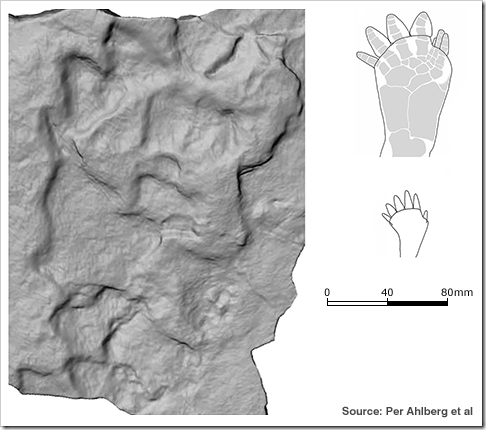Matthew Cobb of Why Evolution Is True writes about some recently found fossil tetrapod footprints that are roughly 20 million years older than the now famous Tiktaalik fossil, which was a lobe-finned fish (not quite having tetrapod status).
Cobb says:
These exquisitely-preserved traces not only date to 397 MY (22 MY years earlier than Tiktaalik) above all they clearly show the marks of feet and toes. They were not made by a lobe-finned fish. They were made by tetrapods. And big ones at that – some of the traces (there are around a dozen of them) suggest the animals were up to 2 metres long.
Paleontologist Grzegorz Niedzwiedzki, who discovered the tracks, originally thought they were dinosaur tracks until he realized that the rocks where the tracks were found were older than the earliest dinosaurs. That’s a pretty cool discovery!

There are no skeletal fossils yet of the creature that made the tracks, so we don’t have an indication of what the creature looked like, but (Cobb again)…
…the fact that they show such clear traces of toes shows that the current view that tetrapods evolved at most 385 MY ago is wrong. Behaviour has trumped anatomy – we can see what the animal did, even if we don’t (yet) know exactly what animal made it. For the moment, these animals are “ghost fossils” – they must have existed, but we don’t know what they were.
There’s even more excitement about this discovery because of its location.
Not an obscure Polish quarry, but the tropical tidal mud-flats that made up the rock that was eventually dug up nearly 400 MY later. It was previously thought that the first steps onto land – like those by Tiktaalik – were made in brackish ponds. The authors correctly write that their discoveries “force a radical reassessment of the timing, ecology and environmental setting of the fish-tetrapod transition, as well as the completeness of the body fossil record”.
PZ Myers talks about the footprints on Pharyngula, too. Here’s an image of the footprints in sequence.

Myers says:
Here are the trackways. Note that what they show is distinct footprints from both the front and hind limbs, not drag marks, and all that that implies: these creatures had jointed limbs with knees and elbows and lifted them and swung them forward to plant in the mud. They were real walkers.
Aside from the really cool discovery, what I also find interesting about this discovery is the attitude of the scientists who are writing about it. There is no obstinate clinging to established understandings of the evolutionary path(s) taken from fish to tetrapod. They happily acknowledge that we have to reassess our understanding based on this new information. There will be plenty of debate, additional research, and disagreements about the implications of the new discovery… but that’s how science works. When new information presents itself, it must be considered and, if it somehow changes our previously deduced conclusions, our conclusions must change.
Ultimately, it leads us to a greater understanding of our world and our history.
And isn’t that the whole point of science?
Update: Brian Switek of Laelaps has a great writeup on this as well!
I just read about this on Pharyngula…. too cool!!
Yeah! Awesome stuff! This is the kind of thing that really builds my enthusiasm for science in general and evolutionary science in particular. 🙂